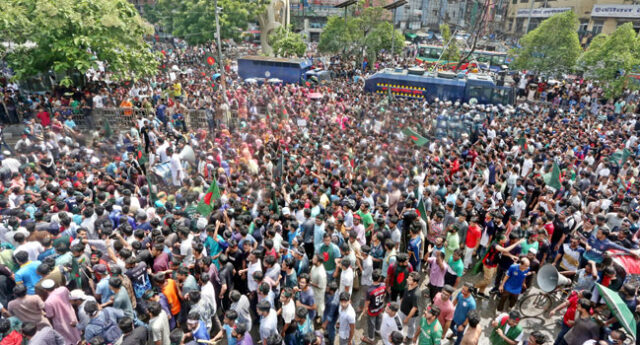- By Major (Rtd) Abdur Rahman Tarafdar
The success of the anti-discrimination movement this time occurred under special circumstances and had unique, unprecedented characteristics. To understand the background and reasons for the movement’s success, we will analyze the failures of previous movements against the government and the government’s success in suppressing those movements.
The Awami League came to power in 2009, almost wiping away its past transgressions. Despite strong suspicions within the army that the government was complicit in the killing of army officers on February 25, 2009, the army could not respond or act as a government institution. Those in the military who raised their voices were suppressed, and the process of infiltrating Awami loyalists into the army began.
From the start of its rule, the Awami League fiercely suppressed any opposition through intense police brutality, backed by the violent student and youth wings of the party. They adopted a strategy of total repression against Jamaat-Shibir, ignoring the minimum norms of law and principles. In fact, the government legitimized the deprivation of their collective and individual civil rights, with the support of certain intellectuals and the media. This was followed by aggressive economic policies, such as the government’s forceful takeover of Islamic banks, actions that stunned many.
The violent suppression of protests reached a climax in 2013 when the government used military-style assault formations to brutally shoot down hundreds of protesters from the Hefazat movement, silencing the protests. At that time, the lack of widespread smartphone access and the government’s ability to black out TV cameras allowed them to bury the massacre. Although some people could sense what had happened, the lack of visual evidence of the bodies prevented mass public outrage. The Hefazat movement was viewed with disdain by the urban elite and leftists, who considered them sub-human. The mainstream media, with its progressive façade, downplayed the atrocities, legitimizing them as appropriate punishment for so-called reactionaries.
Despite the repression, the government faces an electoral challenge every five years. Although the BNP and its alliance captured the country during the 2014 election boycott, they could not control Greater Dhaka. Eventually, the Awami government formed a government with the help of the Jatiya Party in an uncontested election, marking the end of hopes for the fall of the regime. This weakened the BNP’s movement capability, demoralizing its leaders and activists, forcing them to participate in the 2018 election, where they secured only seven seats in a rigged election. The Awami League’s elimination of the caretaker government system and continued elections without voting or with rigged voting allowed the regime to stay in power without legitimacy, supported by police brutality and partisan control of the state apparatus.
The so-called “India factor” played a significant role in this. A belief took root that as long as India supported the Hasina regime, no one could topple it. India’s continued backing of a docile opposition, like the Jatiya Party, in all elections from 2014 to 2024 created a perception that the Awami League only needed to keep India happy to remain in power. This belief rendered people indifferent to movements against the government. The India factor was so demoralizing that even the BNP and Jamaat shifted from their usual anti-India stance to appeasement strategies.
When Hefazat students were killed, the public did not express anger. Similarly, when BNP-Jamaat members were killed, people did not feel personally affected, in part due to dissatisfaction with their rule during their time in power. This allowed the Awami League’s authoritarianism to escalate without facing effective opposition. The phrase “stomach full, back doesn’t hurt” held true during a hollow economic boom that the Awami League boasted about, claiming the country had turned into Singapore. However, the economic bubble burst in 2022, as rampant corruption led to inflation and a collapse in the standard of living, breaking the public’s illusion.
Rising commodity prices caused public suffering, and people started becoming more involved in the movements leading up to the last parliamentary elections. Despite widespread arrests, lawsuits, and intimidation that kept the opposition leadership and activists busy and separated, the movement couldn’t build enough momentum. The opposition failed to dominate the streets, allowing the Awami League’s police and hired thugs to overpower them. Ultimately, the opposition was defeated by bullets, arrests, and assaults.
However, the political context surrounding the most recent election was different. This time, instances of voter fraud were widely documented on social media. For the first time, political activists on platforms like Facebook and YouTube were vocal in exposing the regime’s lies and authoritarianism, inspiring both political activists and the general public while making the government and its forces hesitant to act brutally. Particularly, the U.S. sanctions on certain officials forced part of the ruling elite to act more cautiously. This foreign pressure, combined with social media activism, caused the youth, especially Generation Z, to lose faith in the system, realizing that their voting rights were being taken away through rigged elections.
Unlike previous movements, this time the students’ movement resonated with the public differently. These students were not seen as Hefazat students or Jamaat-Shibir members, often ridiculed and considered backward. They were seen as the nation’s children, fighting for a just cause. This emotional connection between the students and the public, especially parents, fueled the movement. The usual allegations of conspiracy and branding opponents as “traitors” didn’t work this time. The students’ demands were universal, affecting both public and private sector students equally.
The turning point came with the death of a student named Abu Sayeed, whose protest and death became a symbol of the movement. This time, the government couldn’t get away by blaming intruders or outsiders. The leadership of the movement wasn’t centralized, which made it hard for the government to isolate and suppress key leaders. Every step taken to suppress the movement only fueled it further. Even the use of helmeted thugs, a traditional tactic of the Awami League, backfired.
Eventually, faced with mounting public pressure, the government was forced to reduce quotas, a significant victory for the movement. This emboldened the protesters to believe that the fall of the regime was inevitable. The government’s violent suppression, through police and border guards, only intensified the movement. As parents and opposition activists joined, the movement grew stronger, and every attempt to suppress it, including temporary curfews and internet shutdowns, only worsened the situation for the regime.
Finally, the movement triggered a cultural rejection of the Awami League’s oppressive regime and its cult of personality surrounding Sheikh Mujib. Generation Z rejected the political system and the false narratives they were fed, demanding a new era of freedom and equality. Some even called this movement “Independence 2.0” or “Victory 2.0,” believing it would reform the corrupt political system and inspire future generations to build a more just society.










